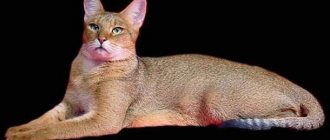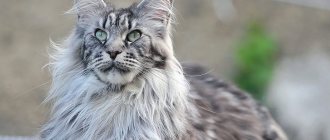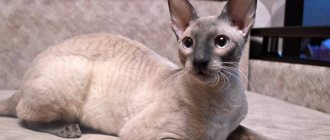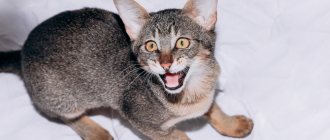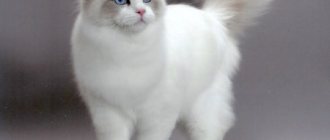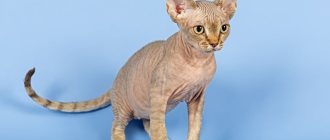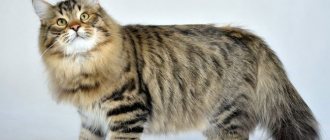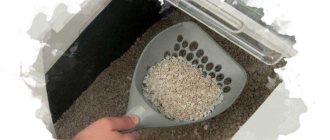- Posted by Olga Petrova
- Date: June 15, 2018
A predatory look, a proud posture and an affectionate character. This is all Chausie - an elite breed of cat that not everyone can afford. She is one of the five most expensive cat breeds.
- 2 Appearance
2.1 Photo gallery: cat breeds for breeding Chausie - 2.2 Photo gallery: acceptable colors of Chausie
- 6.1 Power
- 7.1 Castration and sterilization of Chausie
History of the origin of the Chausie cat breed
The Chausie, or Hausie, is a relatively young breed of cat, even though some scientists date the appearance of their ancestors to the times of Ancient Egypt.
On the frescoes that decorated the palaces, you can find images of cats that were very similar to individuals of this breed. They were treated with respect, as cats were considered sacred animals in Egypt.
Experts suggest that these cute creatures came from crossing a wild jungle cat and a domestic cat. The habitat of the wild ancestors of the Chausie was quite extensive: from South to Central Asia. A small number of them were also common in Africa.
On the frescoes of Ancient Egypt you can find images of cats that look very similar to chausie
For a long time, no one knew about chausie. Only in the late 60s of the 20th century did one American tourist draw attention to unusual cats walking along the streets of Egypt. It took a lot of time to study the Chausie and get healthy offspring. But attempts to develop a new breed were ultimately successful, and in 2003 the Chausie was recognized as an independent breed. The standard was developed 8 years earlier, in 1995, by the international cat association TICA.
Unfortunately, it is very difficult to find such a cat in Russia. The largest number of chausie are concentrated in the USA and France, but there are still very few of them.
Breed care
The Chausie is considered a young breed due to its origin. It is also very expensive, so not everyone can afford to purchase such a representative. Many people do not know how to care for cats, since there is little reliable information on this issue.
Since Chausies are extremely inquisitive and active, you will need to create freedom for your pet. He is shown frequent walks outside, preferably with a leash. It is recommended to purchase more toys so that the animal’s leisure time is not boring.
Mandatory care measures:
- daily combing of the coat using a brush with soft teeth;
- twice a week cleaning of ears and teeth;
- swimming in water with toys;
- regular visits to the doctor for preventive examinations, nail trimming and vaccinations;
- carrying out deworming.
The pet's diet must be balanced and meet the standards. Sometimes let your cat show its hunting instincts. It is important to have a scratching post in the house.
Appearance
The more similar a Chausie cat is to its ancestor, the jungle cat, the better. But since artificial long-term selection involved crossings with other breeds, some external differences from what their wild ancestor looks like are allowed. Over the course of many years of studying this breed, it was determined that in order to obtain healthy kittens and the appearance characteristic of this breed, the Chausie can only be crossed with Abyssinian or regular shorthair cats.
All kittens born are marked according to what percentage of wild jungle cat blood they contain. Accordingly, the following generations of chausie are distinguished:
- F1 is a direct descendant of a male Chausie and a cat, that is, 50% of wild blood flows in him and in appearance such cats are very similar to jungle cats, they have the appropriate temperament and size;
Chausie F1 contains 50% of the blood of a wild cat, so its character and appearance are closer to a predator than to a domestic pet.
- F2 is a descendant of Chausie F1, the share of the blood of the wild ancestor is 25%, the average Chausie has a more loyal temperament, but its weight is 10 kilograms or more.
- F3 is a descendant of Chausie F2, the wild jungle cat has 12.5% blood, it is an animal with the temperament and size of a domestic cat, but with an appearance that is close to the jungle cat.
- F4 and F5 - the proportion of wild blood is less than 12.5%, the cats are fully socialized, have a standard size and build.
Photo gallery: cat breeds for breeding Chausie
Often a simple short-haired cat is chosen as a partner for a Chausie.
From her wild ancestor, Chausie inherited a strong physique and a predatory look
Most often, the Abyssinian cat is chosen as a partner for the Chausie.
Chausie is a fairly large cat, but its weight depends on which generation it belongs to. The body weight of an adult animal can vary from 4 to 15 kg . Accordingly, the closer an animal is to its wild ancestor, the more it weighs. Cats are bigger than cats. The remaining characteristics do not depend on the chausie class:
- the head is elongated, wedge-shaped, medium in size, when compared with the proportions of the body it seems small, the frontal bone is wide, the cheeks are taut, the nose is straight and wide;
- the eyes are almond-shaped, slightly slanted, the color can be yellow, amber or green;
- the ears are wide and erect, set high, it is desirable to have tassels at the tips, characteristic of many wild breeds, which must certainly be black; if the pet is classified as F1, then on the back of the ears there should be a pattern of spots, which are also called the “deceptive eye”;
- the neck is short, stocky;
- the body is large, muscular, but at the same time the chausie is very elegant and graceful, the chest is wide, the shoulders and pelvic bone are narrow, the back is straight and quite wide, the height at the withers is about 40 cm;
- the paws are strong, large, the front ones are noticeably shorter than the hind ones;
- the tail is long, can reach 3/4 of the body length, there is a black tassel at the end;
- the coat is short, close to the body, shiny;
- The colors allowed are black, brown ticking and black tabby, new colors of kittens are constantly appearing, but only Chausies of these three colors can participate in exhibitions.
Photo gallery: acceptable colors of Chausie
The interesting pattern on tabby cats is very attractive to lovers of these animals.
Chausie with brown ticking color is very similar to Abyssinian cats
Chausie's hair should not be monochromatic
Where to buy and what to look for when choosing a kitten
The cost of a Chausie kitten depends directly on the percentage of jungle cat blood in it. Thus, kittens of the F1 generation are the most beautiful and largest, and therefore cost the most - many thousands of dollars and euros. Kittens of the F5 generation will cost less, but they will also look more like a domestic cat than a wild cat.
It is impossible to buy Chausie kittens from an ad. Their breeding is strictly controlled and is permissible only in nurseries, most of which are located in America and France. The cost of a kitten of even the lowest generation will be from a thousand in European currency.
Having decided to purchase a pet of this breed, having found a suitable nursery and seeing a kitten you like there, you should first evaluate its behavior. Under normal conditions, he should be active, playful and inquisitive. If he sits aloof and passive, this should alert you. The color of the kitten's coat must correspond to the standard, the skin must be clean, without any lesions or dandruff. The muzzle should be angular, the ears should be erect and high, wide at the base. There may or may not be tassels - this condition is not necessary. You can pick up a kitten from the nursery at three or four months of age.
Chausie character and behavior
Chausies, despite their wild roots, have a friendly character. They are very sociable and become very attached to their owner. At the same time, they will not get bored with constant meowing and sitting on your lap. Chausies are very smart and delicate.
Chausie becomes very attached to his owner
They do not tolerate loneliness well, so they require the constant presence of a person or other pets. They get along well with animals of their own size or larger, but small pets can become their prey.
Chausies get along very well with children. They are very active and love outdoor games that children play with them. Indifferent attitude towards outsiders. They are not afraid to go out and see who has visited their home, but they will not show their affection. It is important to note that the behavior of a Chausie largely depends on its upbringing. From early childhood, the pet must be taught that human hands and feet are not a toy, then the animal will not scratch or bite as an adult.
Wild roots have left their mark on the activity of the chausie - these are very active and curious animals. When buying this cat, you need to remember that it is unacceptable to keep representatives of the F1 and F2 classes in an apartment. A large space that can be explored without holding back their desire to run around is vital for them. Living in a private home is ideal for these cats.
Representatives of generations F3 and below can be kept in apartment conditions, but the owner must find time every day to communicate and play with the pet, and also regularly walk it on a leash. These cats are quite trainable and are able to follow some simple commands.
It is better to keep Chausie in a private house with access to the yard
The cleanliness of the chausie is also excellent. They often lick themselves for a long time, which saves the owner from endlessly cleaning the room from animal hair.
Reviews
The girl gave me a cat for her birthday. As I understand it, she got it from a nursery. Honestly, I've never been interested in cats. But when I took a closer look at the gift, I realized: a little lynx will live in my house. I don’t know why, but the first association was lynx. So I named the cat (it’s a boy) Rys. Rhys fits well into my life. He is very playful and sociable, we quickly found a common language, I feel that he has become attached to me.
I, as an exemplary owner, read a lot of literature about my pet and learned how demanding these cats are when it comes to nutrition. Yes, at first I spent a lot of time with snacks for my Lynx: I looked for friends to ask for advice on what to feed my pet, I re-read all the books about cats in the local library. When Rys's menu was ready, I breathed a sigh of relief. Now all problems are solved.
I work as a programmer, so I spend most of my time at home at the computer, so my pet does not suffer from attention deficit disorder.
I don’t know, but I think that if I had my own company and spent hours in the office, my cat would go crazy from loneliness. I see how important communication is for him. Stepan, 21 years old
Chausie diseases
In general, Chausies are in good health, but they have a shorter gastrointestinal tract than most domestic cats, so they are not allowed to eat plant foods.
Chausies also have an excellent appetite, which is more like gluttony, so the owner’s lack of control over the pet’s portion size can lead to obesity.
The rest of the recommendations regarding the health of the Chausie are the same as for other cat breeds:
- timely vaccination;
- measures aimed at preventing and getting rid of parasites;
- annual preventive examination by a veterinarian.
It is recommended to visit a veterinarian for a preventive examination at least once a year.
Chausies live quite a long time: their lifespan is about 15–20 years.
Upbringing
Chausies love to play and are easy to train
They begin raising a kitten immediately after it appears in the apartment. Get him used to the scratching post and litter box. Whenever your pet tries to damage furniture or interior items, explain that this cannot be done, using strict intonation. Chausies have a developed intellect and are able to understand what their owner wants from them. Accustom your pet to a leash from an early age.
Video: Chausie performs tricks
How to choose a kitten
Since Chausie is a very rare breed, the cost of kittens is very high: it can start from 100 thousand rubles. There is no ceiling on the price. There is information on the Internet that very wealthy people paid 1 million rubles for one Chausie kitten.
While preparing this material, I found an advertisement for the sale of a Chausie kitten for 30 thousand rubles. But still, I very much doubt that a kitten of this breed can cost so little. The peculiarities of breeding are unlikely to allow the price to be reduced so much. Most likely, a completely different breed is being passed off as a Chausie.
Buying a Chausie kitten is a very difficult undertaking. Since this breed is very small in number, the nurseries with these beauties can be counted on one hand. Breeding Chausies is very difficult, so buying kittens from private breeders is very risky. It is better to contact trusted nurseries.
It is better to buy a kitten when it reaches three months of age: it is at 3 months that the baby can be painlessly separated from its mother.
Externally, the small chausie has the same characteristic features as adult individuals: color, wedge-shaped muzzle, wide, high-set ears, black tip of the tail. The F1 kitten will be very large, its characteristic features are “deceptive eyes” (characteristic stripes and spots on the back of the ears) and the nature of a predator. The F4 kitten has the personality and size of a domestic cat.
Chausie kittens immediately have the color of an adult animal
When buying a kitten, you need to inspect it:
- The baby's belly should not be bloated;
- skin, ears and eyes must be clean;
- the coat is uniform, without bald spots;
- the kitten should be active and curious.
When purchasing a kitten, breeders must provide the following documents:
- contract of sale;
- kitten's metric or completed pedigree;
- veterinary passport with notes on vaccinations and deworming.
When choosing a pet, you should also decide on its gender. Cats are more active and playful, but at a certain period they begin to mark their territory, which, of course, may not please the owner. Kitties are more affectionate, but several times a year during the period of heat they begin to ask to fulfill their destiny: to become a mother. And since these cats are not at all easy to breed, this fact must be taken into account when purchasing an animal. It is also worth considering that some breeders note this feature in female Chausies: they often mark their territory just like cats.
Interesting Facts
A breed that is interesting not only in appearance, but also in its history
. Here are some interesting facts about it:
- often males are born sterile and unable to reproduce;
- unlike most cats, Chausies are partial to water;
- they walk on a leash without any problems;
- Chausies are tolerant of various domestic animals, but not rodents and birds (they are prey for them);
- love to run and jump over obstacles;
- some have tufts on the ears and the tip of the tail, exclusively black;
- this breed is quite specific in appearance (peculiarity in coloring: there are no red, white or gray cats);
- Chausie is also called small pumas;
- animals rarely release their claws during gambling, so those participating are not at risk of injury;
- undemanding to living conditions;
- Cats often guess the wishes of their owners - like psychics.
How to care for your pet
Caring for the Chausie is not difficult at all. Since this cute cat is very clean, it is enough to comb her fur once a week with a massage brush, more to improve blood circulation than to remove dead hairs.
There are no restrictions regarding swimming - Chausies love to swim. There are often cases when they come to their owner’s bathroom while he is bathing and happily jump into the water with him.
Chausies love to swim
Despite the fact that most sources do not contain information on how often you can bathe a Chausie, I still do not recommend doing it more than once every 3 months. Like any cat, the skin of this breed is covered with a special fat, which, if washed off, can lead to problems with the skin.
You need to clean your pet's eyes and ears as needed. Teeth also need periodic examination and cleaning. It is enough to brush your chausie's teeth once a week to prevent the formation of tartar. Claw care will not be required if you have a scratching post, on which the fluffy beauty will regularly sharpen his claws.
With a scratching post, Chausie will be able to take care of his claws himself.
When it comes to toilet training with a Chausie, things are not that simple. The closer a kitten's generation is to its wild ancestor, the more difficult it is to teach it to relieve its needs in a specially designated place, but still this issue is not insoluble. With a certain patience and perseverance of the owner, after some time the Chausie begins to go to the litter box, which should be quite spacious, since this cat is quite large. You can choose any filler.
In my opinion, the best are clumping cat litters. They perfectly absorb odors, leave the cat's paws dry, and you can replace only part of the used litter, and not completely empty the entire contents of the tray.
Some owners even managed to train Chausie to go to the toilet.
Nutrition
As mentioned above, the gastrointestinal tract of the chausie has a peculiarity: it is not able to digest plant foods. The diet of these cats should consist of the following products:
- raw meat of beef, rabbit, poultry;
Chausie diet should be meat
- raw fish;
- raw quail eggs.
The bowl should always contain clean and fresh water, passed through a filter or boiled.
The Chausie's diet is also different from how other cats are fed. If the usual recommendation for feeding kittens is 6 meals a day until they reach 3 months, 4 times at the age of six months and 2 times at 9 months, then it is not recommended to feed Chausie at a young age more than twice a day. And when the animal reaches one year of age, the number of meals should be generally reduced to 1 time per day. At the same age, you need to start practicing a fasting day once a week. The amount of food that should enter the animal’s body should not exceed 5% of its body weight.
Breeders recommend feeding your pet super-premium industrial food. The food must be suitable for cats with sensitive digestion.
Positive and negative traits
Unique creatures for extraordinary people
Any breed has its own advantages and disadvantages. Chausie is no exception. The benefits include:
- get along easily with other household inhabitants;
- treat children with love;
- in the excitement they will not scratch the owner;
- atypical appearance;
- endowed with excellent health;
- sociable, cheerful and lively;
- undemanding in terms of attention.
The disadvantages include:
- are expensive;
- rare (in Russia such representatives can be counted on one hand);
- need a lot of space;
- Infertile cats are often born;
- require a special approach to nutrition, since they cannot eat fatty meats and grains, and raw water (only filtered or boiled) is contraindicated for them;
- cannot stand being alone for a long time, otherwise they begin to damage the furniture, wallpaper and other attributes in the interior;
- are predisposed to gaining excess weight with a sedentary lifestyle;
- expensive to maintain and care.
Breeding Features
When planning to start breeding Chausie, you need to be prepared for many difficulties. Firstly, to get kittens with the appearance of a true chausie, you need to organize a mating with a jungle cat, which is not so easy to find. Even the second generation of kittens will already be deprived of their unique appearance, let alone generations F3 and beyond.
Breeding Chausie is very difficult
Secondly, if it is possible to obtain offspring possessing all the characteristics of the breed, then most of the males will be incapable of procreation. It is these features that primarily determine the high price of these cats.
It has already been said above that mating can only be carried out with Abyssinian or ordinary short-haired cats.
If pregnancy does occur, then it passes without any special features and lasts from 63 to 70 days from the moment of conception. Signs of pregnancy are:
- poor appetite that appears within 10 days after mating;
- lethargy;
- increase and intensification of nipple pigmentation;
- enlarged belly at 6 weeks.
Mating is planned no earlier than the end of the first or second estrus in animals at least 1 year old.
Castration and sterilization of Chausie
Often, when purchasing an animal, breeders immediately discuss the issue of procreation with buyers. If a kitten is not purchased for breeding, then the contract usually states that the owners are obliged to castrate or sterilize the animal. Such individuals are cheaper than those for which mating is allowed.
If further procreation is not planned, then the animal must be castrated. Even if a cat is sterile from birth, this will not be an obstacle for him to mark his territory and loudly ask for a girlfriend. Castration is carried out when the baby teeth change, that is, at about 8 months. It is best to sterilize a cat between 9 and 12 months of age.
Experts do not note any peculiarities in carrying out these operations.
Of course, I would like to immediately make a reservation that attributing castration to cats and sterilization to cats is wrong. In fact, these operations can be performed on both sexes. Castration is the procedure for removing the sex glands and organs responsible for procreation (testes in males, ovaries in females). After this, the production of sex hormones stops. Sterilization is an operation to ligate or remove lobes of the seminal ducts in cats and create obstruction of the fallopian tubes in the cat. But there is an unspoken agreement to use these terms to mean the termination of the ability to reproduce in males and females.
Pregnancy and childbirth
During childbirth it is necessary to help the pet
A cat's pregnancy lasts 63–66 days. The duration is counted from the day of coverage until delivery. Kittens may appear earlier. But if babies are born before day 58, they will not be able to survive.
The signs are as follows:
- The first symptoms of pregnancy are weakness and nausea of the cat for 10 days after coating.
- After 3 weeks, you may notice an enlargement and change in color of the nipples, which turn pink.
- There is a change in appetite. The cat may refuse previously loved food.
- At week 6, the abdomen enlarges, and at week seven, fetal movement is already observed.
Important! In the second half of pregnancy, the cat should not be allowed to climb high furniture or jump. During this period, the female’s center of gravity shifts, which makes it difficult to maintain balance.
For childbirth, prepare:
- The box is 50x60 cm in size. On the walls you can build shelves 5 cm wide, where the kittens will subsequently climb. This will protect children from injury. The cat may lie down unsuccessfully and accidentally crush them.
- Place several layers of newspaper at the bottom of the box; they will absorb moisture. Do not use bedding that wrinkles easily. Kittens can become entangled and suffocate.
- During the first week after birth, maintain the temperature in the box at 29 °C, then reduce it every week by 3 °C to a level of 21 °C. This can be done using a thermostat, air conditioner or infrared lamp (250 W).
You also need to prepare:
- towels;
- napkins;
- scissors treated with alcohol.
Signs of impending labor appear 3–4 days in advance. The cat begins to show anxiety, meow, and refuse food. Her body temperature drops to 36–37 °C, her stomach drops. At this time, you should show the cat the box. If the birth occurs in another place, immediately transfer the babies to the box. The cat begins having contractions 1 hour before the kitten appears and mucous discharge is observed. The birth process lasts from 2 to 6 hours. The intervals between the appearance of kittens are 5–30 minutes.
Important! Between contractions, you can offer your cat milk to restore her strength.
Within 15 minutes after the baby is born, the cat gnaws the umbilical cord. If this does not happen, cut it at a level of 2.5 cm from the tummy using scissors. Next, the placenta comes out, which the cat eats. After the process is completed, she is laid on her side, and the babies begin to suck colostrum. This way they receive all the necessary substances that form the kittens’ immunity.
How much does it cost - price per kitten
Chausie kittens are amazingly cute creatures.
Due to the rarity of the breed, kittens are quite expensive - 600 thousand to 1.5 million rubles. (if you buy in Russia). They should be purchased from specialized nurseries. The best age is 3 months.
How to choose a kitten
When choosing a baby, you need to pay attention to:
- Compliance with standard. They especially look at the color. Pedigree representatives do not have white, gray and red colors. The tassels on the ears and tail are only black.
- Kittens should not be aggressive, even towards strangers.
- Accompanying documentation is required.
- The animal is active.
When purchasing such a kitten, you need to understand that you should not expect purebred offspring from it. Therefore, it will not be possible to compensate your costs in full by selling babies.
